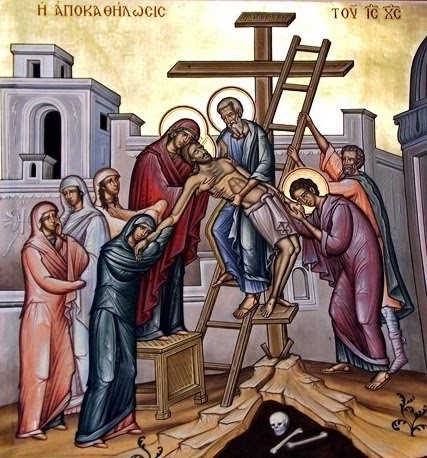
The first service belonging to Holy Saturday—called in the Church the Blessed Sabbath—is the Vespers of Good Friday. It is usually celebrated in the mid-afternoon to commemorate the burial of Jesus.
Before the service begins, a “tomb” is erected in the middle of the church building and is decorated with flowers. Also a special icon which is painted on cloth (in Greek, epitaphios; in Slavonic, plaschanitsa) depicting the dead Saviour is placed on the altar table. In English this icon is often called the winding-sheet.
Vespers begins as usual with hymns about the suffering and death of Christ. After the entrance with the Gospel Book and the singing of Gladsome Light, selections from Exodus, Job, and Isaiah 52 are read. An epistle reading from First Corinthians (1.18–31) is added, and the Gospel is read once more with selections from each of the four accounts of Christ’s crucifixion and burial. The prokeimena and alleluia verses are psalm lines, heard often already in the Good Friday services, prophetic in their meaning:
They divided my garments among them and for my raiment they cast lots (Psalm 22.18).
My God, my God, why hast Thou forsaken me (Ps 22.1).
Thou hast put me in the depths of the Pit, in the regions dark and deep (Ps 88.6).
After more hymns glorifying the death of Christ, while the choir sings the dismissal song of Saint Simeon, the priest vests fully in his dark-colored robes and incenses the winding-sheet which still lies upon the altar table. Then, after the Our Father, while the people sing the troparion of the day, the priest circles the altar table with the winding-sheet carried above his head and places it into the tomb for veneration by the faithful.
The noble Joseph, when he had taken down Thy most pure body from the Tree, wrapped It in fine linen and anointed It with spices, and placed It in a new tomb (Troparion of Holy Saturday).
Written by Fr Thomas Hopko in the book, The Orthodox Fatih
